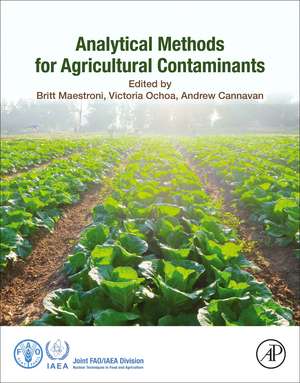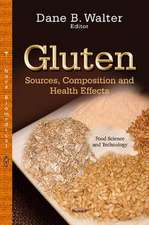Analytical Methods for Agricultural Contaminants
Editat de Britt Maestroni, Victoria Ochoa, Andrew Cannavanen Limba Engleză Paperback – 19 sep 2018
Users in a laboratory setting will find this to be a practical and useful reference on how to detect and control agricultural contaminants for a safe food supply.
- Provides coverage of risk assessment and effective testing technologies
- Presents the most up-to-date information in research sample preparation and method validation to detect chemical residues
- Includes examples of each method for practical application
- Demonstrates proven, reliable research data and the associated quality assurance approaches for end product testing
Preț: 1123.40 lei
Preț vechi: 1583.14 lei
-29% Nou
Puncte Express: 1685
Preț estimativ în valută:
214.95€ • 224.45$ • 177.51£
214.95€ • 224.45$ • 177.51£
Carte tipărită la comandă
Livrare economică 08-22 aprilie
Preluare comenzi: 021 569.72.76
Specificații
ISBN-13: 9780128159408
ISBN-10: 0128159405
Pagini: 200
Dimensiuni: 152 x 229 mm
Greutate: 0.28 kg
Editura: ELSEVIER SCIENCE
ISBN-10: 0128159405
Pagini: 200
Dimensiuni: 152 x 229 mm
Greutate: 0.28 kg
Editura: ELSEVIER SCIENCE
Public țintă
Scientists, researchers, practitioners and students in food safety, food microbiology, food analysis, food toxicologyCuprins
Part 1:
1. Introduction to the book of methods
2. General requirements for food safety analysis
3. Setting up a residues laboratory
4. Sampling in the context of food safety
5. Sample preparation and processing
6. Quality assurance and safety control procedures
7. Method validation
8. Uncertainty estimation
9. Choosing the right method for your purpose
10. Integrated analytical approaches for food safety and environmental sustainability
Examples of methods for food contaminant analysis
PART II- Methods
1. Pesticide residue determination in fresh fruits and vegetables using ethyl acetate extraction and QuEChERS clean-up
2. Extraction of pesticide residues present in fresh fruits and vegetables using the QuECHERS method
3. Analysis of pesticide residues by HPLC MS/ MS in fresh fruits and vegetables
4. Pesticide residue determination in potato using the dispersive QuEChERS template with ammonium acetate
5. Multiresidue method for pesticides in potato using by QuECHERS and GC-MSD detection
6. Processing and extraction of fruits and vegetables with possible pesticide residue content
7. Determination of selected pesticides in tomato samples by column extraction and gel permeation chromatography clean-up
8. Determination of carbamate pesticides residues in honey by HPLC with post-column derivatization and fluorescence detector (FLD)
9. Determination and confirmation of chloramphenicol in honey, fish and prawns by liquid chromatography–tandem mass spectrometry
10. Determination of avermectins and milbemycin residues in food of animal origin by LC-MS/MS
11. Determination of sulphonamides in eggs by high pressure liquid chromatography detection and diode arrangement (HPLC / DAD)
12. Determination of ractopamine in swine feed by LC-MS/MS
13. Determination of histamine in fish and fish products by capillary zone electrophoresis.
Examples of methods for soil and water analysis
14. Determination of carbamates and triazines in soil and sediment samples by high pressure liquid chromatography coupled to mass spectrometry
15. Determination of organophosphorus and other pesticides through ultrasound treatment
16. Determination of selected pesticides by GC-MSD
17. Procedure for extraction of organo phosphate pesticides in water using solid phase extraction
18. Procedure for extraction of organo-chlorinated pesticides in water
19. Determination of organochlorine insecticides and trifluralin in water by GC/MSD
20. Determination of selected pesticides in water by GC-MSD
21. Analysis of residues of glyphosate and aminomethylphosphonic acid (AMPA) in water
22. Determination of nitrate and nitrite in water using unsupressed ion chromatography with UV detection
23. Determination of ammonium in wastewater using unsuppressed ion chromatography with conductivity detection
Examples of methods using nuclear and biological approaches
24. Detection of irradiated fat containing foods through the analysis of 2-alkylcyclobutanones using gas chromatography coupled to mass spectrometry
25. Determination of Radon in water
26. Procedure for the generation of adsorption isotherms in soils using radiotracers
27. Effect of pesticides, drugs and chemical compounds on the soil respiration using 14C –glucose as a radiotracer
28. Determination of the mineralization curve of pesticides in soil using a radiometric technique
29. Biomonitoring of water quality using macroinvertebrate as bioindicators
30. Estimation of the bioaccumulation factor of radiolabelled pollutants in compost worms
1. Introduction to the book of methods
2. General requirements for food safety analysis
3. Setting up a residues laboratory
4. Sampling in the context of food safety
5. Sample preparation and processing
6. Quality assurance and safety control procedures
7. Method validation
8. Uncertainty estimation
9. Choosing the right method for your purpose
10. Integrated analytical approaches for food safety and environmental sustainability
Examples of methods for food contaminant analysis
PART II- Methods
1. Pesticide residue determination in fresh fruits and vegetables using ethyl acetate extraction and QuEChERS clean-up
2. Extraction of pesticide residues present in fresh fruits and vegetables using the QuECHERS method
3. Analysis of pesticide residues by HPLC MS/ MS in fresh fruits and vegetables
4. Pesticide residue determination in potato using the dispersive QuEChERS template with ammonium acetate
5. Multiresidue method for pesticides in potato using by QuECHERS and GC-MSD detection
6. Processing and extraction of fruits and vegetables with possible pesticide residue content
7. Determination of selected pesticides in tomato samples by column extraction and gel permeation chromatography clean-up
8. Determination of carbamate pesticides residues in honey by HPLC with post-column derivatization and fluorescence detector (FLD)
9. Determination and confirmation of chloramphenicol in honey, fish and prawns by liquid chromatography–tandem mass spectrometry
10. Determination of avermectins and milbemycin residues in food of animal origin by LC-MS/MS
11. Determination of sulphonamides in eggs by high pressure liquid chromatography detection and diode arrangement (HPLC / DAD)
12. Determination of ractopamine in swine feed by LC-MS/MS
13. Determination of histamine in fish and fish products by capillary zone electrophoresis.
Examples of methods for soil and water analysis
14. Determination of carbamates and triazines in soil and sediment samples by high pressure liquid chromatography coupled to mass spectrometry
15. Determination of organophosphorus and other pesticides through ultrasound treatment
16. Determination of selected pesticides by GC-MSD
17. Procedure for extraction of organo phosphate pesticides in water using solid phase extraction
18. Procedure for extraction of organo-chlorinated pesticides in water
19. Determination of organochlorine insecticides and trifluralin in water by GC/MSD
20. Determination of selected pesticides in water by GC-MSD
21. Analysis of residues of glyphosate and aminomethylphosphonic acid (AMPA) in water
22. Determination of nitrate and nitrite in water using unsupressed ion chromatography with UV detection
23. Determination of ammonium in wastewater using unsuppressed ion chromatography with conductivity detection
Examples of methods using nuclear and biological approaches
24. Detection of irradiated fat containing foods through the analysis of 2-alkylcyclobutanones using gas chromatography coupled to mass spectrometry
25. Determination of Radon in water
26. Procedure for the generation of adsorption isotherms in soils using radiotracers
27. Effect of pesticides, drugs and chemical compounds on the soil respiration using 14C –glucose as a radiotracer
28. Determination of the mineralization curve of pesticides in soil using a radiometric technique
29. Biomonitoring of water quality using macroinvertebrate as bioindicators
30. Estimation of the bioaccumulation factor of radiolabelled pollutants in compost worms






















